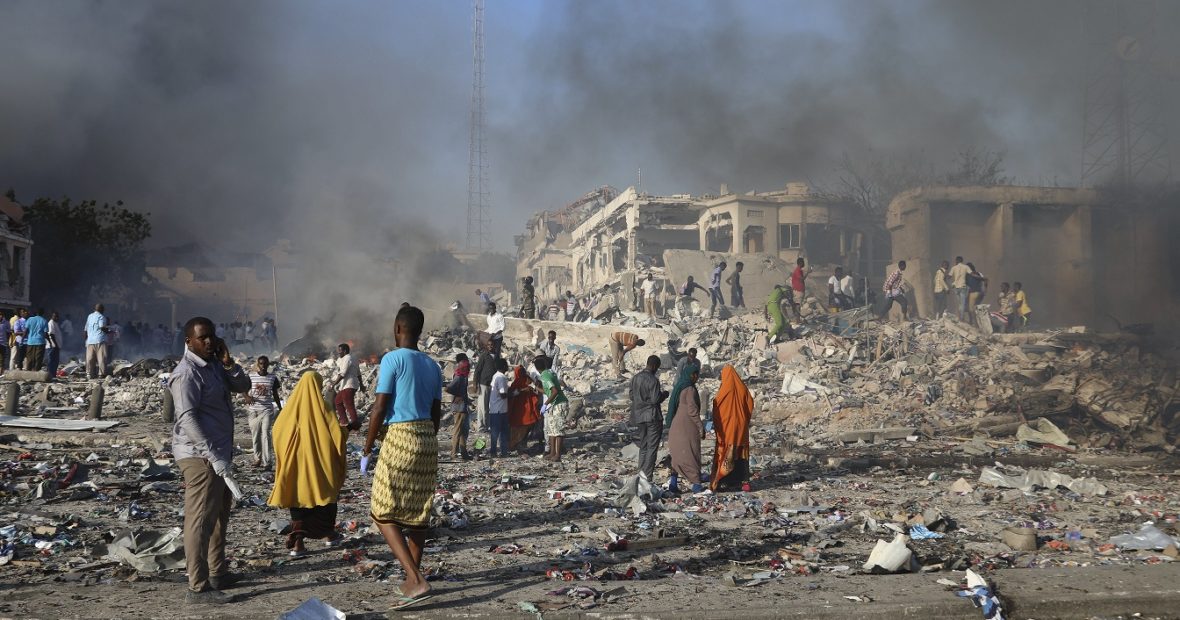In an ideal world, belligerents would not fight within the urban environment. This is not simply due to the dangers that city combat presents to the civilian population, but also because a military commander is less able to exercise command and control over their forces once hostilities commence. Thus, Sun Tzu reminds us that the lowest form of generalship is the attack of a defended city. Yet armed conflict continues to play out upon the urban stage because cities provide the political and economic power necessary for an adversary to conduct hostilities.
The impact of this reality upon the civilian population is stark, for it dictates the conduct of attacks in the most complex battlefield setting—a congested, multidimensional terrain where military objectives are strewn, and often consciously concealed, amidst civilians and civilian objects. There are, consequently, increasing calls for States to avoid urban attacks or, at the very least, to minimize their associated use of explosive weapons with wide area effects. Such pleas understandably highlight the importance of Additional Protocol I (‘AP I’) and customary international law in the progressive development of protection for the victims of armed conflict, particularly the rules requiring the taking of precautions in attack. Yet analysis of those rules indicates that a balanced approach to their application is necessary, one that considers both the humanitarian impact and the military practicalities of urban operations.
Precautions in attack
AP I, Article 57 codifies the rules concerning the taking of precautions in attack and, for this purpose, must be read conjunctively with the broader provisions of AP I that afford general protection for the civilian population from the effects of hostilities. As an overriding consideration, Article 57(1) dictates that ‘[i]n the conduct of military operations, constant care shall be taken to spare the civilian population, civilians and civilian objects.’ This requirement pervades the rules of practical application to be followed when conducting attacks. These rules are set down in Article 57(2) and 57(3), several of which are norms of customary international law.
The substance of those rules will be the subject of future posts in this blog’s series on urban warfare. At the outset, however, it is important to note that the drafting of Article 57 took much time and effort to resolve. This, the Official Records of the Diplomatic Conference (1974-1977) indicate, was the result of divergent opinion between those delegates intent on preserving the freedom to take necessary military action on one hand, and those viewing AP I as an opportunity for imposing greater constraint upon the conduct of hostilities by the great powers. To this extent, rather than dictating a comprehensive statement of the laws of war concerning precautionary measures, the final text of Article 57 reflects a careful balancing of competing military and humanitarian considerations, one struck by pragmatism and consensus.[i] This balance is most prominent in the concept of feasibility, which pervades Article 57.
Feasibility: the ‘art’ of the practically possible
As a term qualifying the obligation to take precautions in attack, feasibility features expressly in Article 57(2)(a)(i). For attacks, this rule requires that those who plan or decide upon an attack:
‘do everything feasible to verify that the objectives to be attacked are neither civilians nor civilian objects and are not subject to special protection but are military objectives within the meaning of Article 52 and that it is not prohibited by the provisions of this Protocol to attack them . . .’
In the same circumstances, Article 57(2)(a)(ii) mandates the taking of ‘all feasible precautions in the choice of means and methods of attack with a view to avoiding, and in any event to minimizing, incidental loss of civilian life, injury to civilians and damage to civilian objects.’
As with many other important terms within the treaty, however, the inability of the AP I delegates to reach a comprehensive agreement resulted in their omission to define feasibility in the final text. Instead, the only interpretative guidance to emerge from the negotiating history is the need to understand feasibility as a means for balancing both humanitarian considerations and those relevant to the success of military operations. Several States emphasized this understanding in their written explanation of vote. [ii] Of relevance also, reservations made by a number of States on their ratification of AP I, including Belgium, Canada, and the U.K., articulate feasible as meaning ‘that which is practicable or practically possible, taking into account all circumstances ruling at the time, including humanitarian and military considerations.’ This later definition is explicitly adopted in Article 3(10) of Amended Protocol II and Article 1(5) of Protocol III of the 1980 Convention on Certain Conventional Weapons (CCW) and is recognized as the established position of States by the ICTY in Galic.
In other words, Article 57 does not impose an absolute obligation to cause no civilian harm. Rather the term feasibility qualifies its scope, which as the Indian delegation to the Diplomatic Conference noted (p. 226 of Volume VI), means the rules do not require an attacking force to take precautionary measures that are beyond its capabilities. Neither do the provisions dictate the taking of precautions rendered impracticable by the immediate battlefield situation.
Verification of military objectives
Applying the concept of feasibility in practice, therefore, the use of specialized unmanned aerial vehicles (UAV) by States with modern armed forces does not set a binding precedent for those States without access to comparable resources. This is because the practical possibility of precautionary measures is contingent on a range of factors, including military capabilities and technological resources. Similarly, environmental conditions may limit the feasibility of using capabilities that are otherwise available. Poor visibility, dust storms, and civilian air safety concerns may each restrict the ability of an attacking force to operate UAV. The opponent’s deliberate use of fires and smoke to neutralize the visual and thermal imagery sensors onboard UAV will also impinge upon the feasibility of taking certain precautionary measures when verifying military objectives.
By contrast, the overarching obligation to balance humanitarian and military considerations means that those who plan and decide upon attacks cannot rely on feasibility as a justification to take action inconsistent with what might be expected of a reasonable military commander in the same circumstances. The inability to use UAV does not, therefore, entitle an attacking force to ignore alternative means of obtaining the information necessary to verify military objectives, particularly in cases where some doubt exists; they cannot close their mind to other options that are practically possible, such as the deployment of ground troops to conduct reconnaissance, among others.
Means and methods of attack
Once the attack of a verified military objective is judged necessary, those responsible for planning and deciding upon that strike must balance military and humanitarian considerations in determining the means and method of attack. However, the urban intermingling of military objectives and civilians and civilian objects, coupled with the continuously evolving complexities of cities in comparison to other combat environments, presents a series of challenges to this balancing act, as the use of precision-guided munitions (PGM) illustrates.
The ability of PGM to accurately strike a precise aim point from distance – sometimes within one metre of the desired target – intuitively suggests their suitability for attacking urban military objectives; as discriminate means of attack that minimize the risk of civilian death and destruction, their use should be prioritized over that of unguided or ‘dumb’ munitions. The ability of PGM to deliver a precise destructive effect against military objectives in open battlefield conditions is, however, no guarantee of similar success against city targets. Their accuracy is liable to a wide range of unique environmental factors. For instance, the saturated electromagnetic spectrum might compromise their navigation systems, or, a simpler scenario, turbulence in the canyons between the multidimensional infrastructure may unpredictably blow the munitions off course.
Yet the employment of PGM also assumes it is possible to pinpoint targets against the urban backdrop. Experience indicates that adversaries choose to fight in cities not only because it is their source of sustenance, but also because the ability to hide amongst the civilian population negates the advantages enjoyed by an attacking force with sophisticated intelligence capabilities. Action by defenders such as restricting physical and electronic access to the city, operating in small tactical cells, using the existing communication networks to mask their electronic footprint, and frequently moving between residential properties, all serve to deny an attacking force the information essential for the discriminate use of PGM, just as they frustrate the use of more conventional ‘dumb’ munitions. Even if sufficient information is available, the adversary’s air defence and anti-access/area-denial capabilities might still prevent aircraft, including armed UAV, from getting close enough to cities to drop their weapons. The same systems might also be able to intercept and destroy PGM in flight, thereby negating the weapon’s ability to accurately strike the verified military objective.
If PGM are impracticable, an attacking commander will need to consider alternative means of attack, including those they might otherwise prefer not to use. As an alternative to airstrikes, for example, the deployment into the city of a ground force might offer the prospect of detaining and thus neutralising an enemy commander. Carrying only small weapons that they can directly fire at the enemy, such a raid might also seemingly present little danger to the civilian population. Without armoured vehicles, the manoeuvre of which the urban terrain restricts, however, infiltrating teams are at increased risk of ambush and prone to fragmentation amidst a city’s microenvironments—basements, houses, commercial buildings, rooftops, streets, and other open spaces. When that risk materializes, combat action can quickly become existential, making civilian death and destruction more difficult to anticipate and avoid.
Finally, even if a commander excludes all other means of attack other than heavy explosive weapons, Article 57(2)(a)(iii) dictates that an attack must not take place if the expected ‘incidental loss of civilian life, injury to civilians, damage to civilian objects, or a combination thereof … would be excessive in relation to the concrete and direct military advantage anticipated,’ or if it would violate any other relevant rule, such as the prohibition of indiscriminate attacks.
Preserving the balance
The preceding practicalities are only a snapshot of the challenges that a military commander might face when conducting military operations in cities – the most complex combat environments within which to fight. Every action generates a chain of reactions, the full effects of which for the civilian population are often impossible to predict.
Given this uncertainty and the corresponding inability of an attacking force to exert control over its operating environment, it is intuitive to err on the side of caution and assert that greater precaution is necessary when conducting military operations in cities. At the same time, however, the military imperative to act persists, even though the presence of a civilian population means that every military operation is likely to affect civilians in some way.
Against this backdrop, the concept of feasibility enables an attacking force to balance the competing military and humanitarian considerations that pervade the conduct of military operations in cities. To be clear, the feasibility of taking a particular precautionary measure depends on the immediate battlefield situation, and of all the attack planning conducted in advance to ensure that the troops would be in the best position to avoid civilian harm. Urban complexities may render impracticable some precautionary measures that would be possible in another combat setting, just as they might demand the taking of precautions that would be unnecessary when attacking military objectives far removed from the civilian population. The targeting of a remote air-defence installation, for instance, would not trigger the requirement to give an effective warning because it will not affect the civilian population. Were the same installation located within a city, however, it would be incumbent upon the attacking force to give advance warning of an attack that may affect the civilian population, unless circumstances do not permit.
By contrast, if the humanitarian benefits of using PGM to conduct a specific urban attack outweigh the military disadvantage of being denied its use at some future time or location, the dangers presented to the civilian population by using an alternative means of attack might oblige the attacking force to utilize PGM as a precautionary measure, irrespective of any preference to employ them elsewhere. To this end, feasibility is the fulcrum upon which military commanders must determine their obligation to take precautions in attack.
Editor’s note: The views expressed in this article are those of the author alone and do not necessarily represent those of the ICRC, British Army, the U.K. Ministry of Defence, or HM Government.
[i] W Hays Parks, ‘Air War and the Law of War’ (1990) Air Force Law Review 1, 79-83
[ii] See, for example, Comments of the Turkish Representative, Official Records of the Diplomatic Conference on the Reaffirmation and Development of International Humanitarian Law Applicable in Armed Conflicts (Geneva 1974-1977) vol VI, 221, para 42. Germany, Italy, and USA made similar comments in their written explanations of vote ibid, 226, 231, 241 (CDDH/SR.24).
See also
- Sahr Muhammedally, Preparedness in urban operations: a commander’s planning checklist to protect civilians, May 11, 2021
- Laurent Gisel, Pilar Gimeno Sarciada, Ken Hume & Abby Zeith, Urban warfare: an age-old problem in need of new solutions, April 27, 2021
- Craig Jones, In good faith: legal advice during aerial targeting in urban areas, May 4, 2021
- Daniel Palmieri, War and the city: a history, April 29, 2021






Comments